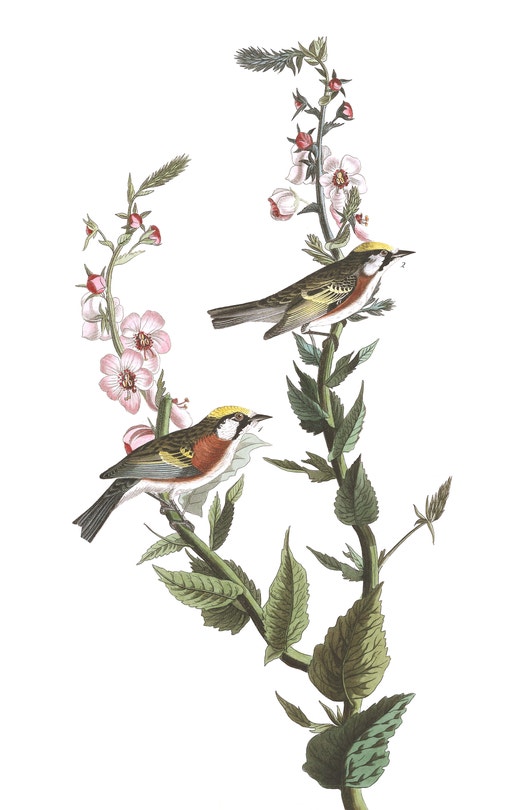May 2.
6 A. M. — Is not the chipping sparrow the commonest heard in the village streets in the mornings now, sitting on an elm or apple tree?
Was it the black and white warbler that I saw this morning? It did not stop to creep round the trunks; was very shy.
Or was it the myrtle-bird?
Might it have been the log-cock woodpecker that I saw yesterday morning?
Reptiles must not be omitted, especially frogs; their croaking is the most earthy sound now, a rustling of the scurf of the earth, not to be overlooked in the awakening of the year. It is such an earth-sound.
The flowers of Cheney's elm are not only much earlier and larger than others, but the peduncles are in separate bundles proceeding from a common short peduncle. There appears to be such a difference, the tree is made of a different form and appearance.\ I can easily break off a twig from its branches, which hang very low. Vide the rough -- barked elm in the swamp, --if it is not the corky elm.
The balm-of-Gilead begins to show its male (?) catkins.
Reptiles must not be omitted, especially frogs; their croaking is the most earthy sound now, a rustling of the scurf of the earth, not to be overlooked in the awakening of the year. It is such an earth-sound.
The flowers of Cheney's elm are not only much earlier and larger than others, but the peduncles are in separate bundles proceeding from a common short peduncle. There appears to be such a difference, the tree is made of a different form and appearance.\ I can easily break off a twig from its branches, which hang very low. Vide the rough -- barked elm in the swamp, --if it is not the corky elm.
The balm-of-Gilead begins to show its male (?) catkins.
The commonplaces of one age or nation make the poetry of another.
I think that my seringo-bird has not the marks of the Savannah sparrow. Looks like a chip-bird; or did I see a spot on its breast?
That white maple, methinks, has a smoother bark tħan the red ones.
P. M. - To Conantum.
The handsome blood-red lacquered marks on the edge and under the edge of the painted tortoise's shell, like the marks on a waiter, concentric, few colors like it in nature. This tortoise, too, like the guttata, painted on these parts of its shell and on legs and tail in this style, but throat bright yellow stripes, sternum dull yellowish or buff.
It hisses like the spotted.
Tortoises everywhere coupling.
Is the male the large and flatter, with depressed sternum? It so seems? There is some regularity in the guttata's spots, — generally a straight row on back. Some of the spots are orange sometimes on the head.
Brought home two little frogs which I have described in the Report (q. v.) but cannot make out. Are they young?
P. M. - To Conantum.
The handsome blood-red lacquered marks on the edge and under the edge of the painted tortoise's shell, like the marks on a waiter, concentric, few colors like it in nature. This tortoise, too, like the guttata, painted on these parts of its shell and on legs and tail in this style, but throat bright yellow stripes, sternum dull yellowish or buff.
It hisses like the spotted.
Tortoises everywhere coupling.
Is the male the large and flatter, with depressed sternum? It so seems? There is some regularity in the guttata's spots, — generally a straight row on back. Some of the spots are orange sometimes on the head.
Brought home two little frogs which I have described in the Report (q. v.) but cannot make out. Are they young?
The andromeda is ready to bloom.
The yellow lily is budded.
The little frogs peep more or less during the day, but chiefly at evening twilight, rarely in the morning. They peep at intervals. One begins, then all join in over the whole pond, and they suddenly stop all together.
If you would obtain insight, avoid anatomy.
I am pretty sure that is the myrtle-bird I see and hear on the Corner road, picking the blossoms of the maple, with the yellow crown and black throat or cheeks. It sings pe-te-te-te-ter twe ', emphasizing the last and repeating the second, third, and fourth fast.
The little frogs I kept three days in the house peeped at evening twilight, though they had been silent all day; never failed; swelled up their little bagpipes, transparent, and as big as a small cherry or a large pea.
Saw a bird on the willows, very shy, which may be the indigo-bird, but I am not sure.
The Equisetum arvense is now in bloom (the male flowers) all over the railroad embankment, coloring it yellowish (?).
H. D. Thoreau, Journal, May 2, 1852
The yellow lily is budded.
The little frogs peep more or less during the day, but chiefly at evening twilight, rarely in the morning. They peep at intervals. One begins, then all join in over the whole pond, and they suddenly stop all together.
If you would obtain insight, avoid anatomy.
I am pretty sure that is the myrtle-bird I see and hear on the Corner road, picking the blossoms of the maple, with the yellow crown and black throat or cheeks. It sings pe-te-te-te-ter twe ', emphasizing the last and repeating the second, third, and fourth fast.
The little frogs I kept three days in the house peeped at evening twilight, though they had been silent all day; never failed; swelled up their little bagpipes, transparent, and as big as a small cherry or a large pea.
Saw a bird on the willows, very shy, which may be the indigo-bird, but I am not sure.
The Equisetum arvense is now in bloom (the male flowers) all over the railroad embankment, coloring it yellowish (?).
H. D. Thoreau, Journal, May 2, 1852












